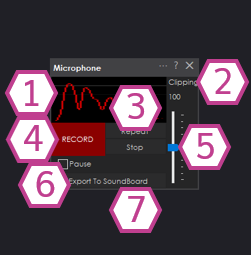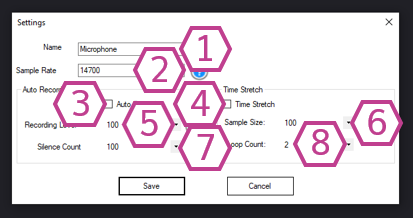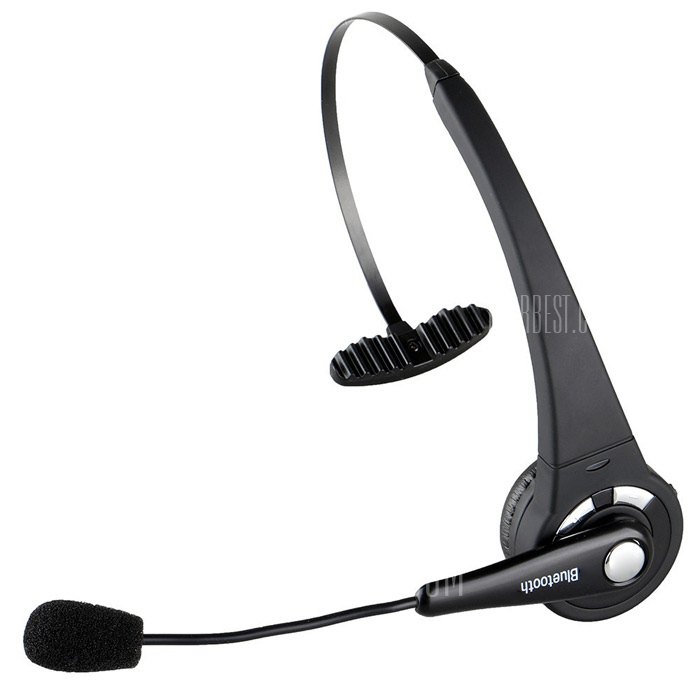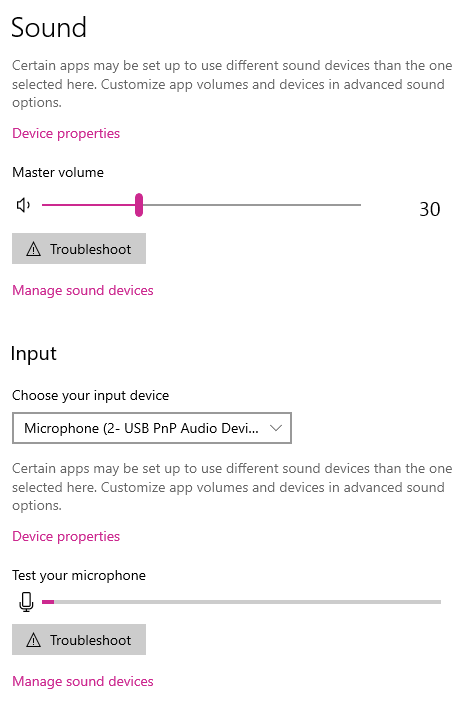Record audio from your PC mic, auto-trigger and edit sample rate/effects, then play or export recordings to an EZ-B v4 SoundBoard for robot playback.
How to add the Microphone robot skill
- Load the most recent release of ARC (Get ARC).
- Press the Project tab from the top menu bar in ARC.
- Press Add Robot Skill from the button ribbon bar in ARC.
- Choose the Audio category tab.
- Press the Microphone icon to add the robot skill to your project.
Don't have a robot yet?
Follow the Getting Started Guide to build a robot and use the Microphone robot skill.
How to use the Microphone robot skill
This skill will record audio from your default audio input device and allow you to play it back through the EZ-B v4 speaker. The Settings menu for this skill will enable you to specify some effects and the sample rate.You may also adjust the recording level to begin recording audio automatically. The audio will be played once the level drops below the threshold.
The most recent recording in the buffer can be exported to a SoundBoard EZ-B v4. This allows you to save the current recording from being played back on demand from a selection of audio files.
Most robots make a lot of noise, so locating the audio input device on a robot is not a practical solution. It is best to find the microphone on the controlling PC/Laptop, on yourself, or somewhere in the room (away from the robot). Experiment with different microphone locations and volumes for the best setup for your environment. Ideally, use a headset or Bluetooth mic rather than your laptop microphone.
Main Window

1. Audio Waveform
This gives visual feedback that your audio input device (microphone) is configured correctly and is picking up voice/sounds.
2. Clipping Threshold
The audio above this grey line threshold will be distorted. Turn down your mic gain to make sure your audio recording is clean.
3. Repeat/Stop Buttons
The repeat button plays back your recording on the EZ-Bv4 speaker, and the stop button stops that playback.
4. Record/Stop Button
The Record button records the sound from the configured audio input device and stores it in a buffer. The same button is used to stop the recording as well.
5. Volume Slider
This slider adjusts the audio volume from the EZ-B v4 speaker, not to be confused with the microphone volume/gain.
6. Pause Checkbox
This checkbox pauses the input capture of audio from the input device.
7. Export to Soundboard Button
This button takes the recording from the buffer and places it in the selected row of the Sound Board (EZB) skill.
Settings

1. Title Field
This field contains the title of the microphone skill. You can change it if you'd like. *Note: Changing the title here will also change the title in the controlCommand() associated with this skill.
2. Sample Rate Field
This field allows you to change the audio sample rate. Changing the sample rate will increase or decrease the speed of the playback.
3. Auto Record Checkbox
This checkbox will allow the microphone to automatically start recording audio if sound above the Recording level value is detected.
4. Time Stretch Checkbox
This checkbox will allow the recorded audio to be slowed down. Changing the Sample size will decrease the recording speed; the smaller the number, the slower the audio playback.
5. Recording Level Drop-down
This drop-down will allow the microphone to automatically start recording audio if sound above the Recording level value is detected. The higher the level value, the higher the sound will have to be detected.
6. Sample Size Drop-down
This drop-down will decrease the recording speed; the smaller the number, the slower the audio playback.
7. Silence Count Drop-down
This drop-down selects the time between the last detected sound above the Recording level and when the automatic audio playback will commence.
8. Loop Count Drop-down
This loop count selection will make the recording sound more robotic the higher it is set. But there is a trade-off; as the loop value increases, the playback will be slower.
How to Use the Microphone Skill
1) Install, configure and test your audio input device (see instructions below).
2) Add the Microphone Skill to your ARC project (Project -> Add Skill -> Audio -> Microphone).
3) If you want to save the recorded audio, optionally add the Sound Board (EZB) to your ARC project (Project -> Add Skill -> Audio -> Sound Board (EZB)).
4) Connect to an EZB that supports audio playback.
5) Verify an activity with the Audio Waveform in the Main Window, then press the Record button.
6) When you are done recording, press the Stop button and then click the Export to Sound Board button to be able to play it back through the EZ-B v4 speaker.
Requirements
Headset or External Mic

A headset or external mic will produce dramatically better results than the internal PC/Laptop mic. A headset or mic will enable the recognition engine to "hear" your voice much clearer with less background noise. The background noise of the laptop, motors, radio, and room echo will cause the recognition software to return False Positives. This means the software recognizes an incorrect phrase. An external mic will also prevent the recognition software from hearing the robot speak. In short, it is important to use a Mic Headset or external Mic for a positive Speech Recognition experience.
Resources
Configure Audio Input Device

You might have to adjust the microphone input volume/gain. To adjust the mic volume, use the Microsoft Windows volume mixer, and first, make sure you have selected the correct input device. Your laptop or computer may have a few different mic devices. Maybe one is on a remote camera. Find the mic you'd like to use and adjust the volume. To find the volume settings that are ideal on your computer, follow these steps:
1) Right-click on the little speaker on your system tray
2) Select "Open Sound Settings."
3) In the "Input" section of the Sound Settings, you'll notice a little VU meter beside the active device. Make sure your active device is indeed the microphone you want to use. By making sounds, the VU meter should move.
4) Click on the "Device Properties" and locate the volume slider for the microphone. We usually have our volume set for 78. Play around with different volumes until you see your voice being picked up by the VU meter. Adjust the volume input level/gain to display your voice's regular volume near the middle of the VU Display graph.
Related Tutorials
tutorial

Break Out Sound Hack: Ez-B V4 External Sound Hack
Add a 3.5mm headphone jack to an EZ-B to connect wired speakers for audio output in Synthiam ARC-DIY hack with...
tutorial

The Robot Program Episode 012: Getting Adventurebot To Move
Control Revolution AdventureBot via WiFi, use color tracking, RoboScratch programming, and execute wheeled movement.
tutorial

The Robot Program Episode 006: Introducing ARC
EZ-Builder robot software: explore layout, options and features to navigate controls and build and program robots.
tutorial

The Robot Program Episode 023: Mobile JD
Control Revolution JD Humanoid from iOS/Android: connect to Mobile JD project, run basic controls and access programming...
Related Questions
question

Functions Not Working
Problems: 1 - Microphone dose not record. it registers on the wave form but pushing record does not change colour stays...
question

Error Playing Audio
What does the following error mean when playing an audio file using PlayAudio command? My files are MP3 but I might...
question

Recording Audio To Send To AI Platform
How can I record audio from the microphone for an extended period, such as up to 10 minutes? I want to capture a person...
Upgrade to ARC Pro
Experience the transformation – subscribe to Synthiam ARC Pro and watch your robot evolve into a marvel of innovation and intelligence.


Am I correct in thinking the microphone app only works with the EZ- B v4 unit, when it is connected and can't record and play through the pc?
I did try this and it only works with the EZ-B v4 unit
Also on the camera, video recording, I am using a USB camera with mic, only the video records no audio, correct?
Camera is video only for tracking objects with computer vision. It’s not a video camera as you’d use for home movies.
as for the audio of the camera or audio in general using the pc mic. There’s free tools better than ARC can provide, such as audicity, which we recommend
Press the ? (Question mark) on any control to receive help information and tutorials on that control. Lots of details available for you
Thanks for all you help
You can delete this question if you like, I don't know how to take it off
Questions stay for ever to help others in the future. If you can, ask questions in the appropriate content. For example, if you want to know if there's an iphone app for virtual reality robot, ask it one time in the virtual reality robot thread . That's how we keep things organized
. That's how we keep things organized
You'll notice this question has been moved into the microphone content thread to help people find similar answers in the future
Hi, how could I use JD's microphones without having to use an external pc microphone? thanks
The JD EZ-Robot does not have a microphone